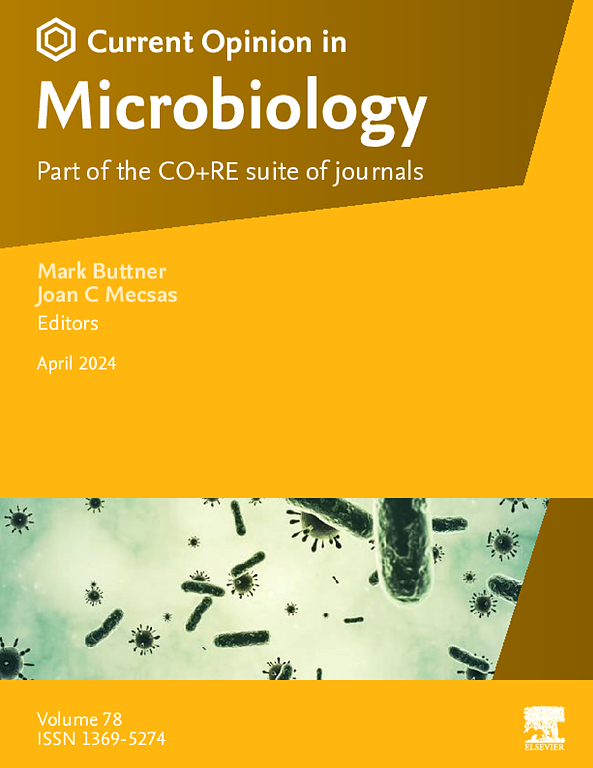Compartmentalization during bacterial spore formation
IF 7.5
2区 生物学
Q1 MICROBIOLOGY
引用次数: 0
Abstract
Here, we explore the recent advancements in understanding cellular compartmentalization during bacterial spore formation, primarily focusing on the model organism Bacillus subtilis. The hallmark of sporulation, asymmetric septation, physically separates the mother cell and forespore, enabling distinct developmental fates. We highlight the role of the asymmetric septum as an organizational hub coordinating diverse compartmentalized functions — from gene regulation to metabolism and protein synthesis machinery localization.
Asymmetric septation involves precise positioning of the division machinery, chromosome segregation, and septal pore formation. Recent studies have revealed detailed structure of the asymmetric septum and its role in maintaining compartment integrity, especially through interactions involving SpoIIE, SpoIIIE, peptidoglycan remodeling enzymes (like the SpoIIDMP complex), and the SpoIIIA-SpoIIQ channel. The asymmetric septum also plays a role in the spatiotemporal localization of ribosomes, with their entry into the forespore being coupled to septal peptidoglycan remodeling. This observation not only demonstrates translational compartmentalization during sporulation but also reveals the uncoupling of transcription and translation processes in B. subtilis. Moreover, the mother cell and forespore establish distinct metabolic roles, as the mother cell supplies essential metabolites to the forespore through the SpoIIIA-SpoIIQ feeding tube channel, supporting the synthesis of the spore structural components necessary for spore maturation.
Advanced imaging techniques and multi-omics approaches have significantly enhanced our understanding of compartmentalization during sporulation. We conclude by discussing future research directions, including the application of machine learning approaches, expansion of research to nonmodel bacterial species, and exploration of evolutionary aspects of compartmentalization, which may reveal universal mechanisms of microbial organization.
细菌孢子形成过程中的区隔化
在这里,我们探讨了理解细菌孢子形成过程中的细胞区隔化的最新进展,主要集中在模式生物枯草芽孢杆菌上。孢子形成的标志是不对称分裂,它在物理上将母细胞和前孢子分开,从而形成不同的发育命运。我们强调了不对称隔膜作为组织枢纽的作用,协调各种区隔功能-从基因调控到代谢和蛋白质合成机制定位。不对称分裂包括分裂机制的精确定位、染色体分离和间隔孔的形成。最近的研究揭示了不对称隔膜的详细结构及其在维持室完整性方面的作用,特别是通过涉及SpoIIE、SpoIIE、肽聚糖重塑酶(如SpoIIDMP复合物)和spoiia - spoiiq通道的相互作用。不对称的中隔也在核糖体的时空定位中起作用,核糖体进入前孢子与中隔肽聚糖重构相耦合。这一观察结果不仅证明了芽孢杆菌孢子形成过程中的翻译区隔化,而且揭示了枯草芽孢杆菌转录和翻译过程的不耦合。此外,母细胞和前孢子建立了不同的代谢角色,母细胞通过spoiia - spoiiq进料管通道向前孢子提供必需的代谢物,支持孢子成熟所需的孢子结构成分的合成。先进的成像技术和多组学方法大大提高了我们对孢子形成过程中区隔化的理解。最后,我们讨论了未来的研究方向,包括机器学习方法的应用,对非模式细菌物种的研究扩展,以及对区隔化进化方面的探索,这可能揭示微生物组织的普遍机制。
本文章由计算机程序翻译,如有差异,请以英文原文为准。
求助全文
约1分钟内获得全文
求助全文
来源期刊

Current opinion in microbiology
生物-微生物学
CiteScore
10.00
自引率
0.00%
发文量
114
审稿时长
6-12 weeks
期刊介绍:
Current Opinion in Microbiology is a systematic review journal that aims to provide specialists with a unique and educational platform to keep up-to-date with the expanding volume of information published in the field of microbiology. It consists of 6 issues per year covering the following 11 sections, each of which is reviewed once a year:
Host-microbe interactions: bacteria
Cell regulation
Environmental microbiology
Host-microbe interactions: fungi/parasites/viruses
Antimicrobials
Microbial systems biology
Growth and development: eukaryotes/prokaryotes
 求助内容:
求助内容: 应助结果提醒方式:
应助结果提醒方式:


